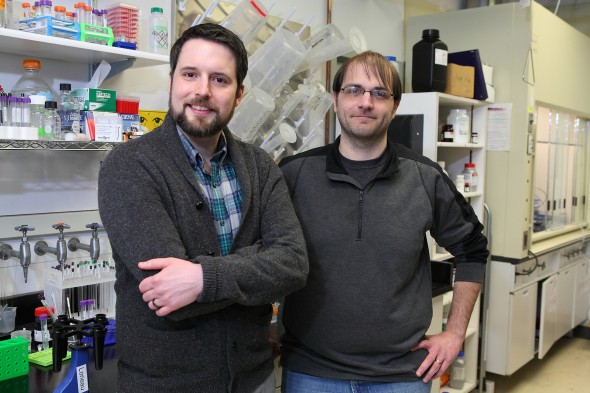Chemists win NSF CAREER Awards
Two chemistry researchers have been named recipients of major early career awards totaling more than $1.6 million from the National Science Foundation.
The five-year grants support early career-development activities of “those teacher-scholars who most effectively integrate research and education within the context of the mission of their organization.”
Justin Lorieau, assistant professor of chemistry, will receive $220,000 annually via an NSF CAREER grant through the foundation’s Division of Molecular and Cellular Biosciences.
Justin Mohr, assistant professor of chemistry, will receive more than $100,000 per year through an NSF CAREER award from the NSF’s Division of Chemistry.
Lorieau will use his award to lead a project that investigates how the influenza virus infects cells at a molecular level and answer questions related to viral infections.
“On cellular entry, the hemagglutinin protein on the virus surface latches into the endosomal membrane of the host cell and promotes fusion with the viral membrane,” he explained. “We study the mechanism of the hemagglutinin fusion peptide domain to understand how this highly conserved sequence is needed for the fusion process.”
Understanding how the fusion peptide functions could lead to new universal treatments for all flu serotypes, and it informs our understanding of related diseases, including HIV, Ebola, MERS and SARS viruses, Lorieau said.
The educational components of the project include incorporating graduate students, undergraduates and research experiments in the classroom with molecular techniques in modern biophysics.
Mohr’s UIC-based research group specializes in synthetic organic chemistry with research focusing on reaction discovery, catalysis, and the synthesis of biologically active molecules.
The NSF award will support Mohr’s project to develop new catalysts useful for synthesizing complex molecules. He said the reactions will improve the overall efficiency of chemical synthesis and have potential applications in medicinal chemistry, agrochemicals, and materials science.
“Our goal is to learn how to control reactive molecules containing unpaired electrons,” Mohr said. “We use inexpensive catalysts to efficiently form these intermediates and then put them to use in the construction of new chemical bonds in a controlled fashion. This strategy allows us to synthesize molecules in fewer chemical operations and to generate a specific spatial arrangement of the atoms that is difficult to obtain using currently available methods.”
Mohr’s project also includes the development of new educational tools and activities to explain complex science topics to students from kindergarten through college.
One effort involves introducing the concept of catalysts to middle school students by using the copper and zinc found in a penny. He plans to pilot the program with middle school students at the Joseph Sears School in Kenilworth.
“Understanding the principles of catalysis helps prepare students for learning more complex concepts of chemical reactivity,” he said.

